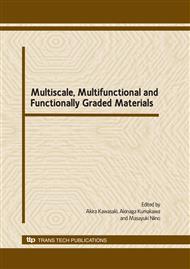p.53
p.59
p.65
p.73
p.79
p.85
p.91
p.97
p.103
Analysis and Simulation of FGM Thermal Barrier Coatings Hot Burner Testing
Abstract:
For FGM thermal barrier coatings thermal-mechanical fatigue due to temperature cycling is one of the critical parameters which determine the lifetime of the TBC. In Tohoku University, a method known as “hot burner test” has been developed and was implemented into the standard JIS H 7851. For further optimization of the testing conditions and selection of the parameters for comparison of different test results knowledge of temperature and heat flux inside the test jig is necessary. FEM analysis of the heat flux and temperature inside the 14 mm diameter test stainless steel jig has been performed. Homogenous YSZ top coat with NiCrAlY bondcoat as well as FGM TBC with different gradation profiles were compared. Distributions of the temperature and heat flux are critical at the edges of the test piece and thermocouples locations, which must be taken into account when comparing test data for coatings with rather different composition and structure. The largest stress gradients develop at the ceramic-metal interface (duplex) and near the edges of the TBC.
Info:
Periodical:
Pages:
79-84
Citation:
Online since:
October 2009
Authors:
Keywords:
Price:
Сopyright:
© 2010 Trans Tech Publications Ltd. All Rights Reserved
Share:
Citation:


